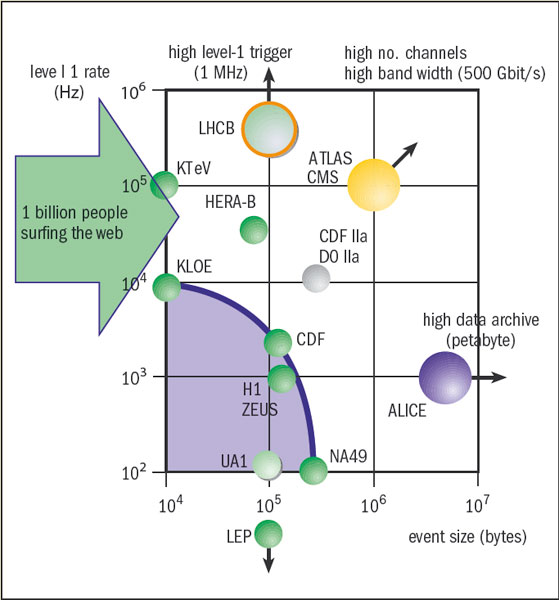The Grid gets EU funds
Plans for the next generation of network-based information-handling systems took a major step forward when the European Union’s Fifth Framework Information Society Technologies programme concluded negotiations to fund the Data Grid research and development project. The project was submitted to the EU by a consortium of 21 bodies involved in a variety of sciences, from high-energy physics to Earth observation and biology, as well as computer sciences and industry. CERN is the leading and coordinating partner in the project.
Starting from this year, the Data Grid project will receive in excess of €9.8 million for three years to develop middleware (software) to deploy applications on widely distributed computing systems. In addition to receiving EU support, the enterprise is being substantially underwritten by funding agencies from a number of CERN’s member states. Due to the large volume of data that it will produce, CERN’s LHC collider will be an important component of the Data Grid.
As far as CERN is concerned, this programme of work will integrate well into the computing testbed activity that is already planned for the LHC. Indeed, the model for the distributed computing architecture that Data Grid will implement is largely based on the results of the MONARC (Models of Networked Analysis at Regional Centres for LHC experiments) project.
The work that the project will involve has been divided into numbered subsections, or “work packages” (WP). CERN’s main contribution will be to three of these work packages: WP 2, dedicated to data management and data replication; WP 4, which will look at computing-fabric management; and WP 8, which will deal with high-energy physics applications. Most of the resources for WP 8 will come from the four major LHC experimental collaborations: ATLAS, CMS, ALICE and LHCb.
Other work will cover areas such as workload management (coordinated by the INFN in Italy), monitoring and mass storage (coordinated in the UK by the PPARC funding authority and the UK Rutherford Appleton Laboratory) and testbed and networking (coordinated in France by IN2P3 and the CNRS).
• March 2001 p5 (abridged).
The Gigabyte System Network
To mark the major international Telecom ’99 exhibition in Geneva, CERN staged a demonstration of the world’s fastest computer-networking standard, the Gigabyte System Network. This is a new networking standard developed by the High-Performance Networking Forum, which is a worldwide collaboration between industry and academia. Telecom ’99 delegates came to CERN to see the new standard in action.
GSN is the first networking standard capable of handling the enormous data rates expected from the LHC experiments. It has a capacity of 800 Mbyte/s (that’s getting on for a full-length feature film), making it attractive beyond the realms of scientific research. Internet service providers, for example, expect to require these data rates to supply high-quality multimedia across the Internet within a few years. Today, however, most home network users have to be content with 5 kbyte/s, or about a single frame. Even CERN, one of Europe’s largest networking centres, currently has a total external capacity of only 22 Mbyte/s.
• November 1999 p10 (abridged).
Approval for Grid project for LHC computing
The first phase of the impressive Computing Grid project for CERN’s LHC was approved at a special meeting of CERN’s Council, its governing body, on 20 September.

• October 2001 p32 (extract).
After LHC commissioning, the collider’s four giant detectors will be accumulating more than 10 million Gbytes of particle-collision data each year (equivalent to the contents of about 20 million CD-ROMs). To handle this will require a thousand times the computing power available at CERN today.
Nearly 10 000 scientists, at hundreds of universities round the world, will group in virtual communities to analyse this LHC data. The strategy relies on the coordinated deployment of communications technologies at hundreds of institutes via an intricately interconnected worldwide grid of tens of thousands of computers and storage devices.
The LHC Computing Grid project will proceed in two phases. Phase 1, to be activated in 2002 and continuing in 2003 and 2004, will develop the prototype equipment and techniques necessary for the data-intensive scientific computing of the LHC era. In 2005, 2006 and 2007, Phase 2 of the project, which will build on the experience gained in the first phase, will construct the production version of the LHC Computing Grid.
Phase 1 will require an investment at CERN of SFr30_million (some €20 million) which will come from contributions from CERN’s member states and major involvement of industrial sponsors. More than 50 positions for young professionals will be created. Significant investments are also being made by participants in the LHC programme, particularly in the US and Japan, as well as Europe.
• November 2001 p5 (abridged).





